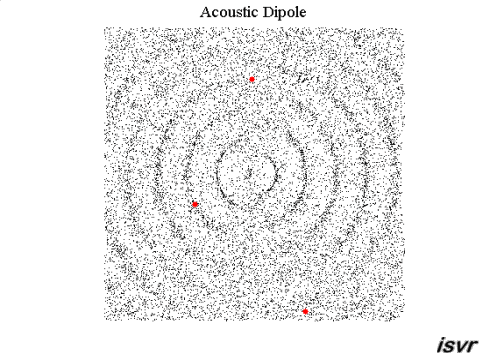DIPOLES
The simplest dipole source consists of two
point
sources, or 'monopoles' of equal strength placed an infinitesimally short distance apart, operating at the
same frequency but always vibrating 180o out of phase with each other. An
example is given by a loudspeaker that has been removed from its box. The
volume of air pushed out from the front of the loudspeaker is compensated for by the
new volume of air that is pulled in from the back. This is a much less
efficient way of radiating sound, as
you will see if you try playing sound through a loudspeaker without a box. The animations below show that a dipole source does not
radiate sound equally well in all directions. Sound is cancelled in the
regions along the vertical axes.

The contour plot below
shows the
pressure field produced by a dipole. Red represents the highest pressure
and blue the lowest pressure.

QUADRUPOLES

An observer holding and
rotating a vibrating tuning fork at arm's length from the ear will hear two
loud regions in the plane of the tines separated by two quiet regions in
the plane perpendicular to the fork. From the animations below, it can be
seen that a similar sound field can be produced by a longitudinal quadrupole
source. It is made of two dipoles lying on the same
line, but oscillating in opposite phase.

When the observer holds and
rotates the vibrating tuning fork close to his ear, he then finds four
positions where the sound is loud, alternating with four positions where
the sound is quiet. The movies below show that a lateral quadrupole
source can provide a similar sound field. It is made of four monopoles
with alternating phase located at the corners of a square.

|
DIPOLE |
LONGITUDINAL QUADRUPOLE |
LATERAL QUADRUPOLE |
|
 |

|

|
|